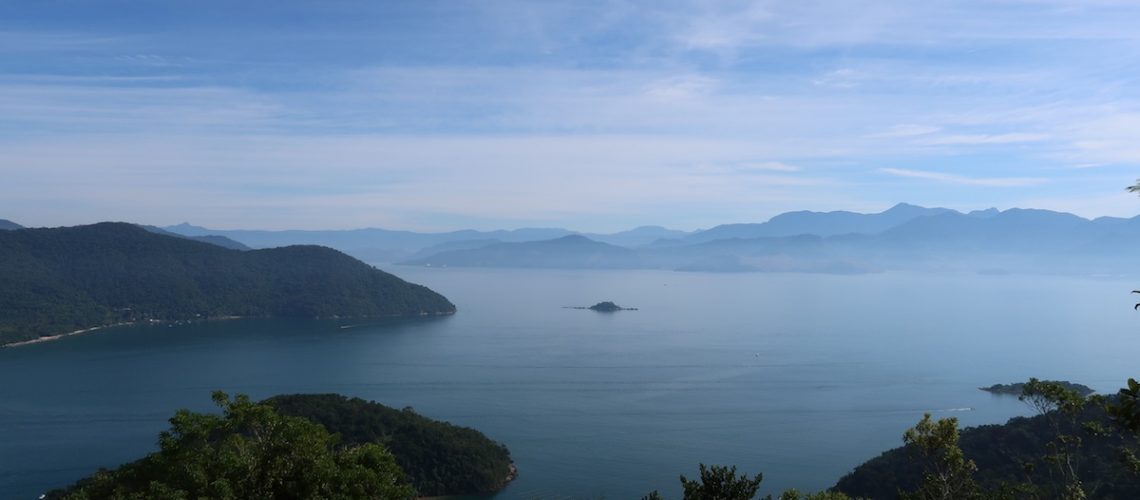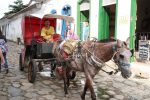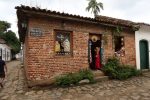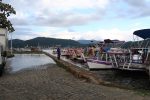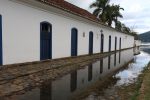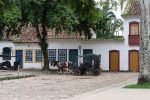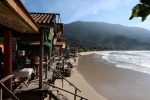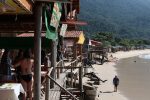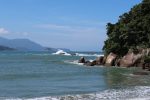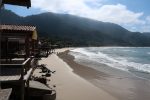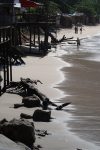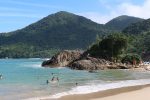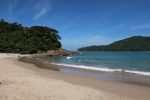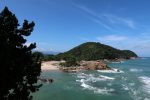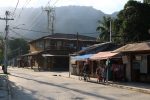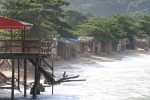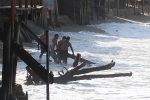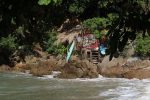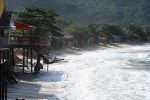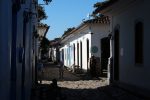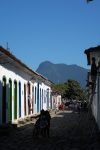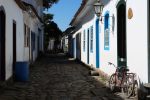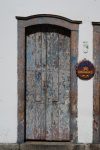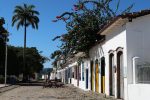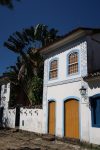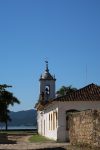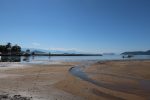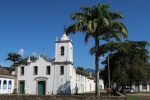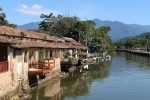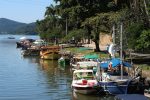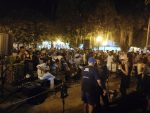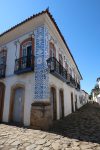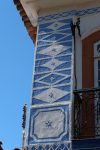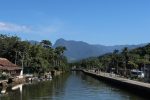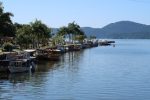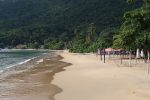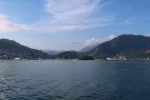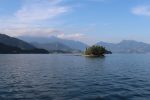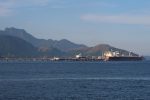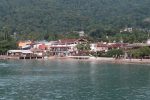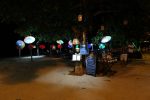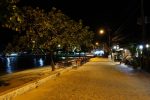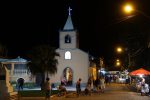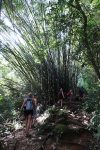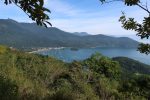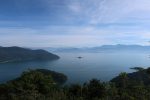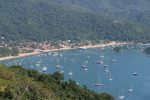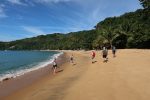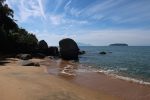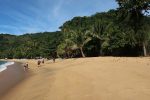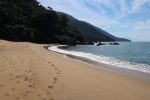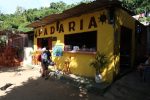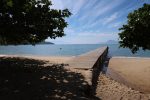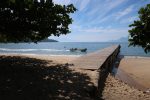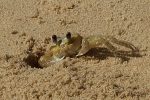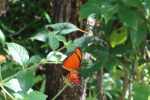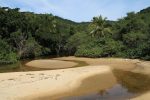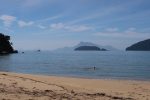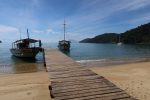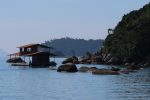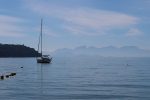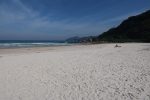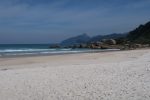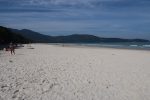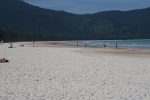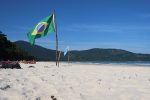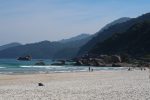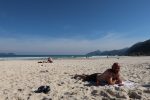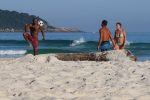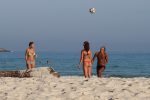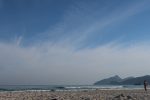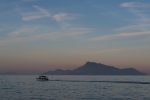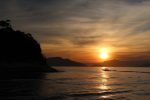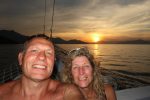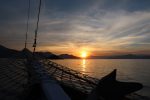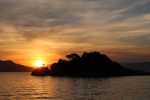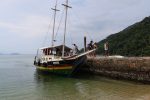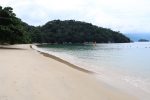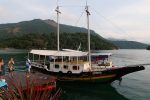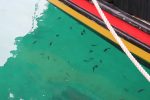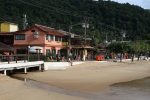Brazil’s Costa Verde stretches from Rio de Janeiro, around the coast to the city of São Paulo. It is a stunning, verdant coastline, with jungle and and Brazil’s Atlantic Rainforest reaching the ocean. Mountains drop straight into the warm blue seas with pristine sandy bays and beaches providing the finishing touches.
We approached it after spending a couple of nights in Rio, but we’ll come back later to there. First, I want to take you around the Costa Verde to the town of Paraty and then on to the splendour of Ilha Grande.
Paraty is about a four hour drive from Rio on a local bus which takes you along the coast road, hugging the coastline and affording wonderful views of mountains, rainforest and offshore islands. Oddly though, even though we travelled around glorious coastline there are pockets of industry tucked away. An oil terminal, one of the biggest in the area and a nuclear power plant can be found on the coast. This amongst an area of outstanding biodiversity and natural beauty.
We arrived at the bus station in the middle of the small town, the most westerly in the Rio de Janeiro province.. It is small enough to walk around its historic centre from end to end. This meant that the last bit of the journey was strolling through the back streets. Settled in to our hostal, we headed out with Guillermo to his suggested lunch spot.
Now I haven’t come across this concept before, but in Brazil we found it quite popular. The little cafe we visited served a buffet style lunch. But it’s not of the ‘eat as much as you want’ variety. You do choose as much as you want but you only pay for what you’ve taken. When you get to the counter your plate is weighed and you are charged per gram for what’s on your plate.
The food selection was fantastic too. One guy was cooking over a churrasqueira (a barbecue) and would pretty much cook meat to your liking. There was also a wide array of vegetable dishes, fish, salads etc.
The small interior was already fairly full of locals, but due to the quick turnover of food and tables there was soon room for us to sit and eat. Real fast food, and really tasty.
We tried to work out how the business model would work out. Would you end up losing money if everyone ate steak? I think we ended up thinking that if you filled your plate with steak it would weigh more than a plate full of leaves so you’d pay more. But that’s about as far as we got as it there was another town to explore.
Paraty itself is an old Portuguese colony, dating from the late 1500s. The historic centre, largely unaltered since the 18th century, is lined with colourful houses, and the streets are made from what appear to be boulders (as opposed to cobblestones). And they are very uneven. High heels and stilettos are definitely not the order of the day for walking around the town.
Historically, Paraty was once a port used for exporting the gold mined in the area back to Lisbon. It was also an important stop off between Rio and São Paulo as it is roughly half way between the two cities. When a new inland road was opened between them in the 1800s Paraty was forgotten. Time and progress passed it by until it was rediscovered and reborn in the 1970s as a tourist destination.
Now it is popular for its historic centre, its natural beauty, beaches, mountains and for the cultural events that now take place here. Music and jazz, and literary festivals sit alongside a festival celebrating cachaça (the local Brazilian sugar cane liquor) which at one time was synonymous with Paraty (a century ago cachaça was apparently called Parati!). And all this set amongst that verdant green backdrop and the aquamarine sea.
Walking is the way to get about in Paraty. Motorised vehicles are banned from the historic centre (except on Wednesdays for deliveries), so the only alternative to walking is to use one of the horse and carts that are commonly seen about the streets. Alongside the boulder like roads are raised pavements. They’re equally uneven and raised up to 30cm from the level of the street. There is a purpose to this, every month, when the moon is full, the extra high tide floods in through purpose made gaps in the sea wall and washes the streets.
Oh yes. It is also hot here. We were there in May, wintertime, and the temperatures were still into the thirties which accompanied by high humidity made it feel pretty warm. Walking (hiking through jungle for example) meant that I ended up drenched in perspiration and dripping. Fortunately the warm seas provide a perfect way to freshen up a bit.
It sounds idyllic, but what is there to actually do in Paraty? A walk around the historic centre and around the river and sea front is definitely rewarding. There’s a peace about the place. A laid back, chilled and relaxed atmosphere. Nobody really seems in a hurry to do anything. Although obviously a tourist destination, there’s no hard sell here from vendors. Some of the streets are almost deserted just adding to that peaceful feel.
It is also an incredibly photogenic place. The white buildings, terracotta roofs and cobalt skies contrasting against each other.
Away from the historic centre are beaches and jungle and the sea.
Get a local bus for the 45 minute ride to Trindade and you find yourself on a near deserted piece of coast backed at one end by a few rickety restaurants on stilts. They were more rickety than normal I think. Some high tides had washed away the steps down to the beach so it was a jump down onto the beach where the steps were missing. No health and safety considerations here.
Taking a stroll back toward the town it’s only a few minutes walk to another bay, but this one better sheltered from the waves and currents. You can also walk along the beach, over a small jungle covered hill to another massive bay. This one with no restaurants or people. Just an expanse of white sand fringed by Jungle and hills on one side and the sea on the other.
Hopefully you’re getting the idea by now that this part of Brazil is a beach lover’s paradise.
Small Paraty may be, but it’s still possible to get lost.
Following the group for the 5 minute walk from bar to beach, Helen, deeply engrossed in world changing discussions with one of the other girls on the group walked straight past the path down to the sea.
I found them half an hour later standing at the bus stop waiting for someone to find them.
It’s not all beaches though. On our first evening, after a wander through the town and dinner in the evening, Guillermo announced that in the square there would be some samba going on. Being keen to experience some of the local culture we picked our way carefully along the dark uneven streets to the town square.
It was absolutely full of people. Pretty much all locals, surrounding a seemingly makeshift band of six or seven musicians playing a fantastic beat. Around them everyone was dancing.
Local guys tried to get the few tourists there were around dancing too.
The atmosphere was cheerful, friendly and fun. Everyone seemed to be having a great time, young and old alike.
In contrast to Rio, of which more later, Paraty is a completely different world. There’s no feeling that you need to keep your eyes open for everything and anyone lurking around. No hard sell on the beaches. In fact, there’s not really any ‘sell’ at all. The beaches we saw didn’t even have much in the way of beach bars or any other commercialisation.
But we didn’t have much time to enjoy the calm and tranquility of this historic place. After a second evening of finding local music, this time a singer at a local beach restaurant, we were heading back in the direction of Rio to the small harbour town of Angra dos Reis. Our minibus dropped us at a decidedly down beat jetty where an equally down beat ferry was waiting to take us the few miles across the bay to the Island of Ilha Grande.
If I’m honest, the ferry looked in need of a fair bit of TLC, whilst rust is not uncommon on seagoing vessels this seemed to have as much rust as paint in some places. Probably best not to look too closely. On the plus side it floated. And the engines worked. And as it was early evening as we made our way over to the island the sun setting made for a glorious trip in the golden evening light.
Ilha Grande. My knowledge of South America and Brazil was limited and I’d not even heard of Ilha Grande before it appeared on our itinerary.
Today 87% of the island’s 193 km2 is protected as a National Park, protecting one of the most pristine remnants of Brazil’s Atlantic Rainforest and one of the world’s richest eco systems. Eco tourism is Ilha Grande’s main industry now, but until 1994 and for 100 years before that it was closed off to the world.
For centuries the island had had an unsavoury reputation. Firstly it was notorious as a pirates lair, then it was established as a leper colony and most recently as the home for Cândido Mendes, a high security penitentiary housing some of Brazil’s most dangerous inmates. The prison was finally decommissioned in 1994 when all but one of the inmates were relocated to other establishments across the country. The one last prisoner was released and allegedly still lives within the walls of the old prison.
This reputation, and the unpalatable use of the island kept people and developers well away. This has resulted in Ilha Grande retaining tens of miles of unspoiled beaches (apparently there are 100 just on the main island) and acres of pristine jungle, the home to many rare species.
There are still only a handful of settlements on the island. The main village of Vila do Abraão is home to a mere 1900 residents, tiny by mainland standards. There are no vehicles there other than a couple of tractors that tow trailers around to collect garbage and consequently no roads other than a couple of dirt tracks. Until recently there were no ATMs either, and the solitary one that has been installed is often empty at peak times so bringing cash with you is essential.
Instead of roads there are miles of trails through the jungle, into the heart of the island and around the the myriad beaches making it a paradise for hikers and nature lovers.
It has to rate as one of the most beautiful, laid back and relaxed places I’ve ever visited. Evenings are spent eating at one of the restaurants on the beach with the gentle waves just a metre or two form your table and days either hiking to exquisite beaches or taking the lazy way out and catching a water taxi.
The best thing is that thee is virtually no commercialisation. No pumping bass, no hard sell and no tacky tourist shops.
We wanted to see the island, so Guillermo’s offer to guide us to one of Brazil’s finest beaches, Lopes Mendes, was not one to turn our noses up at.
I mentioned the climate earlier. It was definitely a warm day. Some would say hot. And humid. Thank goodness we were there in winter! Apparently in summer temperatures can reach almost 40 degrees, so a mere 30 degrees was almost Arctic. This meant that our three hour hike for me was a pretty sweaty affair. I dispensed with the t-shirt early on on the basis that it would save washing it later on but it didn’t prevent the perspiration. In the jungle there was no breeze, so no cooling effect, and I ended up as wet as if I’d just emerged from the sea.
I can’t actually decide which part of the day was the best.
The hike took us through jungle, inland and back to the coast. Along beach after pristine beach, all of which were almost deserted. We climbed to a view point overlooking Abraão and the coast then back down to the sea once more.
When we eventually arrived at Lopes Mendes it more than justified the effort and the perspiration. Strolling across the gleaming white sand toward the azure sea, the sand is so fine that it actually squeaks under your feet. And the sea… Warm, blue and inviting.
Some other members of our party (the younger ones as it happens) had taken the water taxi so had already established a spot near the only food and drink available anywhere along the mile of the crescent beach. A makeshift stall brought over that morning by boat selling sandwiches, crisps, soda and most importantly cold beer. But first a refreshing dip in that inviting water.
The beach wasn’t deserted, it is one of the most popular in the island, but had we walked for 10 minutes we would have been alone. However, being in proximity to that few people there had some merits. People watching is always a good pass time and we saw fine examples of the BBL (‘Brazilian Butt Lift’), the thong (both positive and truly off putting on some, let’s say, larger bodies that probably shouldn’t have been sporting that kind of attire) and the Brazilian’s love of, and skill at, football.
In front of where we were lazing about was a young group of local men and women. They were basically just playing keepie uppie with a football. But the levels of skill were incredible. They would use every part of their body apart form their arms, and the ball just never seemed to hit the sand.
The girls were as good as the boys too, and it all just seemed completely natural to all of them. No wonder the Brazilians have one of the most skilful soccer teams in the world.
We didn’t fancy another three hour walk back finishing in the dark so we decided on the water taxi option to get home. A short walk back through the jungle saw us get back to the jetty where a small crowd waited for the last boat back to civilisation. This time the boat did look seaworthy, and we headed to the bow for the trip back. As it turned out it was the perfect place to sit as the sun set ahead of us as we chugged lazily back along the coast.
Our walking hadn’t quite finished yet though. Our hostel, a quiet place with a stream running down the valley behind it and a plethora of insects and giant grasshoppers, was up a quite steep, dark, path up the hill behind the village.
Sully, one of our Kiwi companions had, the previous evening, grabbed a guitar and started to sing at the beach restaurant we dined at and today he had managed to get Guillermo to commandeer a guitar to have a team sing along. If I’m honest the amount of participation was disappointing. I think most people were enjoying a shower to rid themselves of the salt rather than enjoying our renditions of a number of popular tunes.
The guitar featured the next day too as we headed out again for a day exploring the coast on another boat. This time we headed to the Lagoa Azul (Blue Lake) for some snorkelling and then on to a beach house where we were presented an outdoor lunch, more snorkelling, kayaks and hammocks.
The snorkelling rivalled that we had done in the Seychelles and Australia. Jumping off the boat, you just hope the fish swimming about the hull get out of the way. Guillermo said that there were some fish that stay close to the bottom with fins like wings that they spread to scare off predators. I saw them, they were spectacular, four long fins almost as big as the fish itself. When extended (they normally keep them folded along their bodies) the edges glow like a blue neon sign in the sunlight filtering down through the shallow waters. There was also a small ray that one of the girls spotted. It wasn’t moving so I wondered if in fact it was still alive. I dived down and touched it gently. It still didn’t move, but when I surfaced and looked back down it lazily swam off a few metres and settled onto the bottom once more.
Lunch was delicious, I went back in the water so didn’t try the kayaks (Helen did) and my hammock went unused too.
For the second day running our boat got us back to the village after dark.
Paraty and Ilha Grande. Two hours from Rio, and now with Norwegian Airlines offering budget flights to South America this has to be one of the best tropical regions you can visit on a reasonable budget from the UK today. If you like pristine beaches, nature, hiking, food and culture you can’t go wrong. As I write this I want to go back. Our time there (as in so many places we visited) was brief, and there is so much more to see and do there.
But now, for us, it’s back to Rio for the last city and last leg of our journey. This time by speedboat back to the mainland and a two hour bus ride.
Since we visited Paraty and Ilha Grande in May, they were inscribed as UNESCO World Heritage Sites on 5 July 2019.
